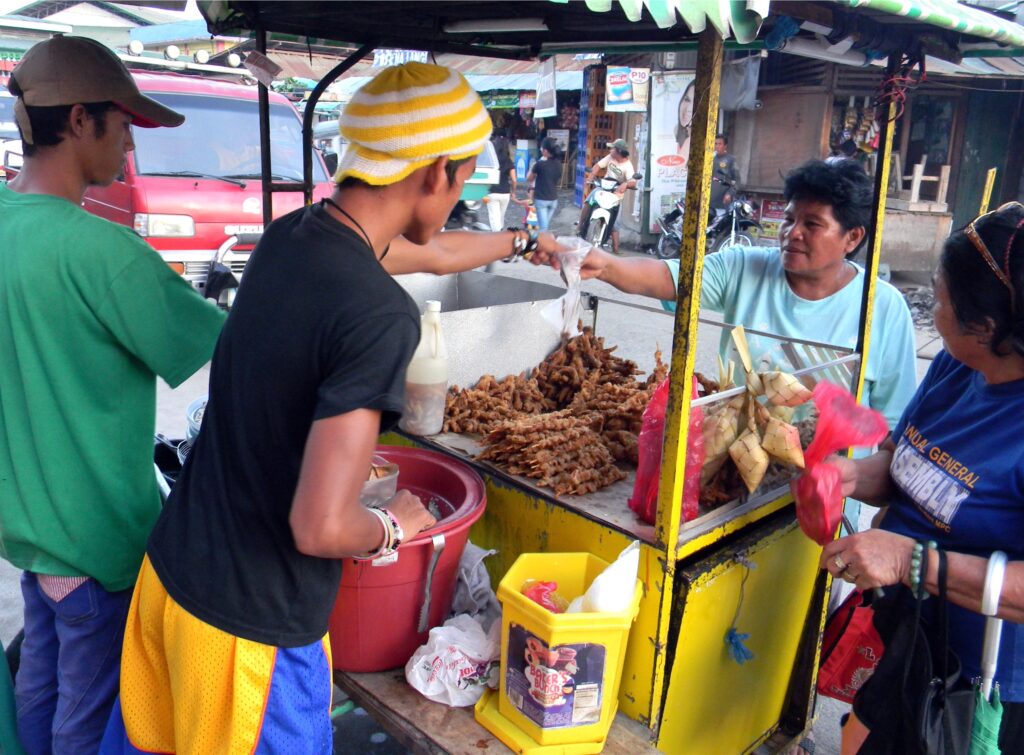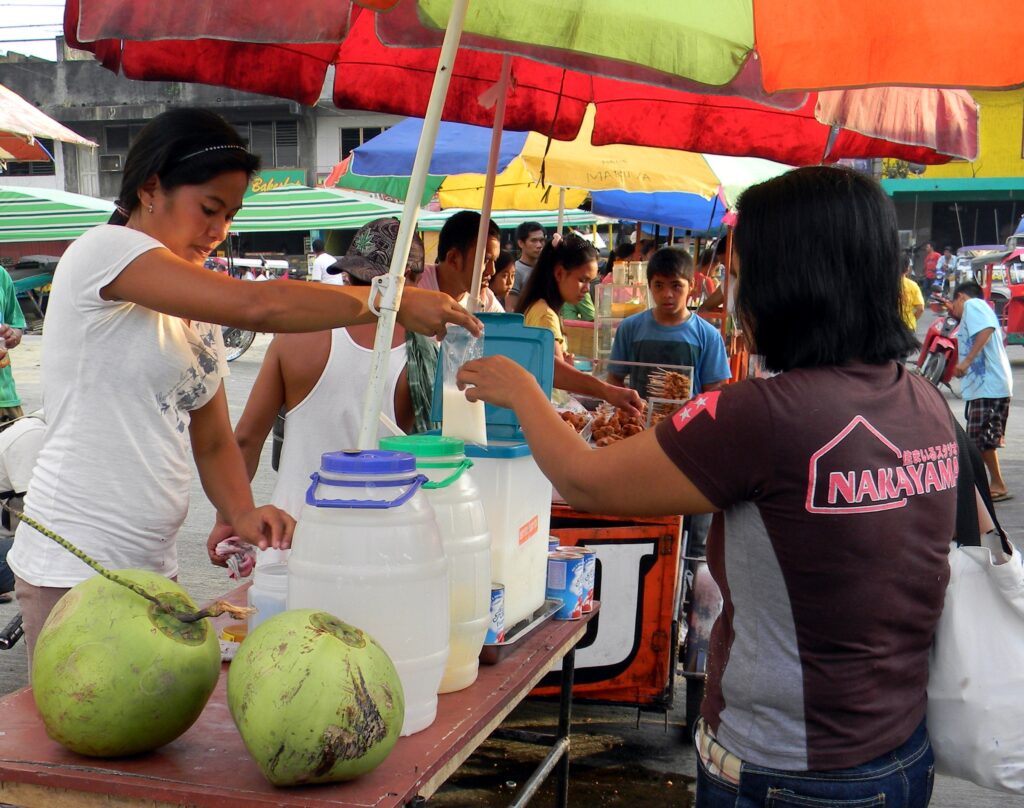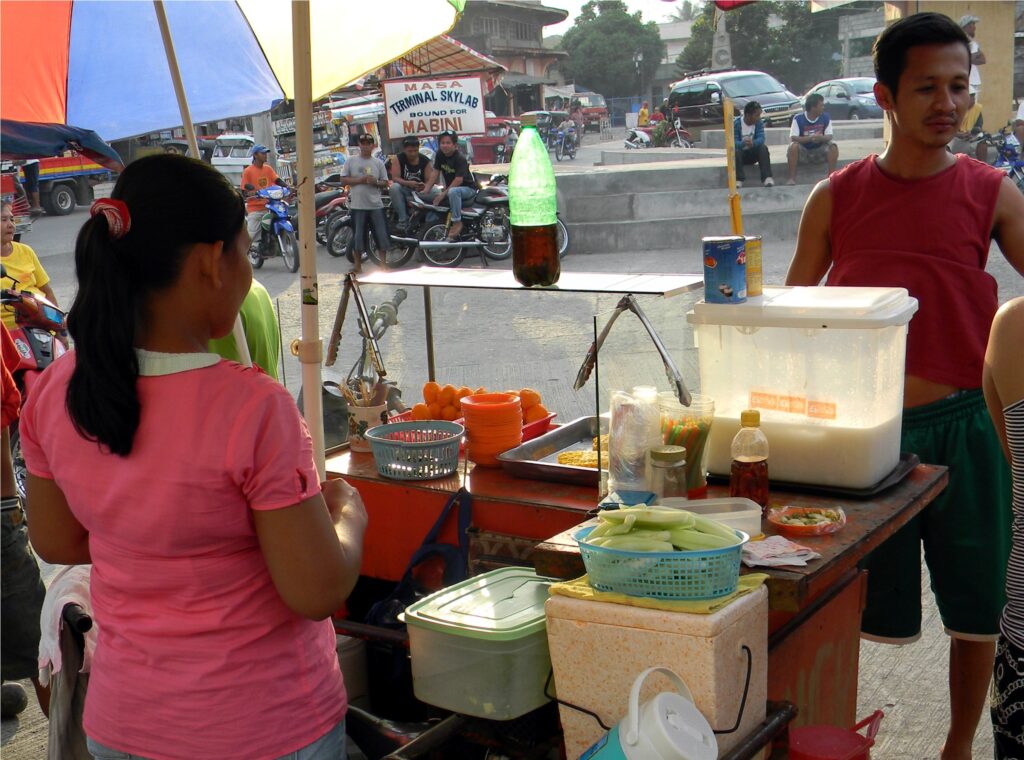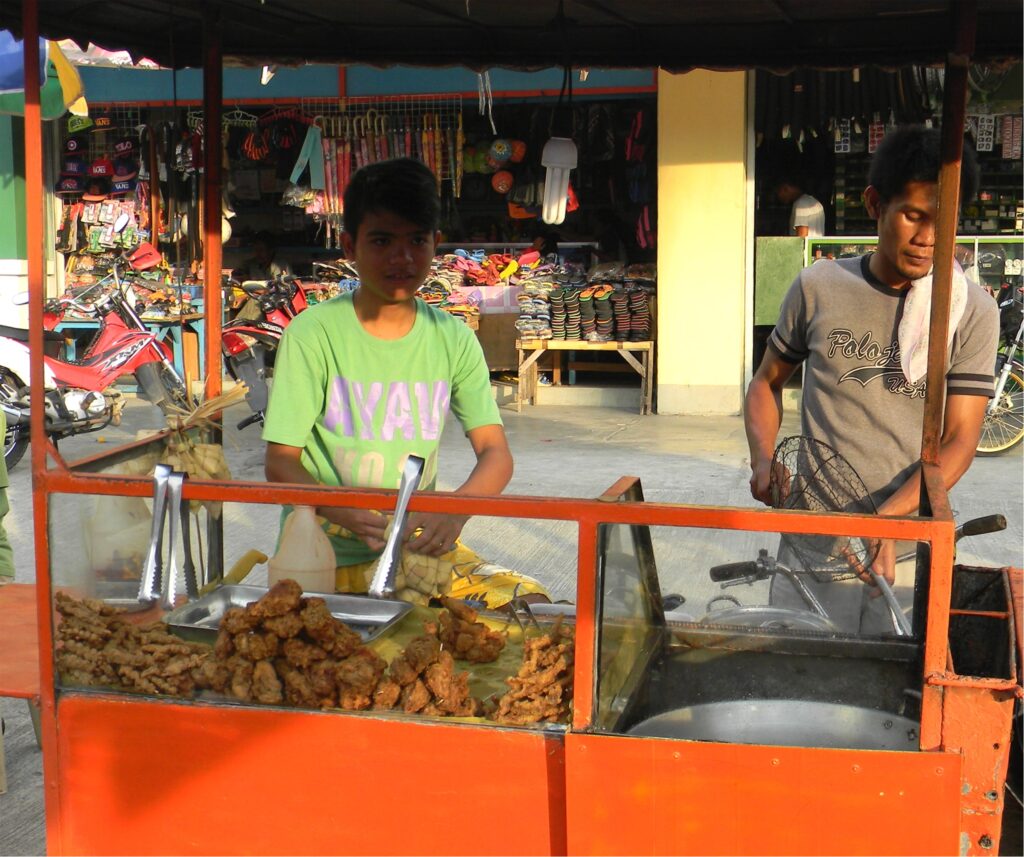Text and Photos by Henrylito D. Tacio
“I love eating street food,” says Cassandra James, a British-American writer who’s been a long Bangkok resident in Thailand. “It’s healthy, delicious and perfectly safe, particularly if you know where to eat it and how to order it. Tourists, on the other hand, come to Thailand and avoid eating street food, simply because they don’t trust it and think they’ll get sick.”
Street foods run the gamut from snack to a full meal, simple to sophisticated. Nuts and fruits, tea, and soda pop are available almost everywhere in most developing countries.

In the Philippines, selling street foods is becoming an important economic activity. It feeds hungry millions and provides employment and income to 80-90% of the country’s urban poor, according to a study done by the Food and Nutrition Research Institute (FNRI).
There are many types of foods sold in the street and among the favorites are: “kwek-kwek” (made of quail eggs covered in orange dough and deep-fried), “isaw” (chicken intestine put on a stick and grilled), fish balls (minced fish rolled into balls), “balut” (pre-hatched duck egg), “betamax” (cubed, curdled blood of a chicken), “adidas” (the marinated grilled chicken’s feet), “atay” (marinated and barbequed liver of chicken), and helmet (the grilled head of a chicken).
Other fillers of hungry stomachs are: “maruya” (a combination of bananas and flour, deep-fried until golden brown), “kikiam” (made of ground pork and vegetables wrapped in bean curd sheets then deep-fried until golden), “calamares” (deep-fried battered squid rings), “mais” (corn on a cob, but it could also be salted boiled corn), and green mango with “bagoong” (unripe mango on a stick with a salty, fermented sauce or paste made from small shrimps or fish).

For drinks, the following are common: buko juice (coconut juice that can be drunk directly from the buko itself), “iskrambol” (a simple shake with artificial flavors), and sago and “gulaman” (a refreshingly cold drink made out of tapioca and jelly).
Ronald M. Henson, in an article that appeared in “The S&T Post,” a publication of the Department of Science and Technology (DOST), Ronald M. Henson, said that the rapid increase of the urban population in the country created a huge market for street foods. This is especially true among the low-income groups who have no time to cook their own meals.
In some instances, working housewives would resort to buying street foods as most of them lack proper cooking facilities. “And with increasing cost of fuel, the only immediate option is to turn to street foods,” noted Henson.
Recent studies have shown that sometimes even the rich and middle-class Filipinos also cater to street foods for a special and popular meal prepared by a particular vendor (“suki”).
As well as being cheap, street foods can also be nutritious. A study in Calcutta, India, found that an average meal contained about 30 grams of protein, 15 grams of fat and 180 grams of carbohydrates.
As population surges and the economy booms, street foods become a familiar thing. “Commonly associated with rapid urbanization, the street foods are a phenomenon in a busy world, operating in areas where commercial activity is bullish, and pedestrian traffic is heaviest,” observed Henson.
Local authorities, international organizations, and consumer associations are increasingly aware of the socio-economic importance of street foods and their associated risks. “With the increasing pace of globalization and tourism,” the UN Food and Agriculture (FAO) said in a statement, “the safety of street food has become one of the major concerns of public health, and a focus for governments and scientists to raise public awareness.”

But are street foods safe to eat? A DOST study conducted a couple of years back discovered that most of the samples taken from the street food sold in four urban centers – in Davao, Cagayan de Oro, Laguna, and University of the Philippines Diliman campus in Quezon City – did not pass quality standards.
(Some previous studies conducted by FNRI showed that microorganism contamination of street food was mainly due to poor handling and unhygienic practices of both vendors and consumers.)
In the DOST study, microbiological findings indicated the presence of coliforms such as Escherichia coli, Enterobacterae aerogenes, and E. cloacae in both barbecued and deep-fried animal by-products. This means that the selected food samples’ bacteria load was rather high, ranging from 240 to 2,400 per gram of food.

In a study done by the US-based Equity Policy Center, it was found that the largest single problem of the street food industry in most of the developing countries is the lack of access to clean water for washing utensils and hands.
“Where clean water is hard to obtain, a single bucket of untreated water might serve throughout the day, a banana leaf floating on top to hide the filth,” the study noted.
One of the health problems people may suffer from eating bacteria-laden food street is food poisoning. “Some bacteria work by secreting toxins that affect the whole body, including the digestive tract. Others work by directly attacking the lining of the intestines,” explains The Doctors Book of Home Remedies.

According to Dr. William B. Ruderman, chairman of Gastroenterology at the Cleveland Clinic-Florida in Fort Lauderdale, when you find yourself infected with bacteria or a virus that causes food poisoning, you may simply have to be miserable for a short time until your immune system responds and fights off the infection.
So the next question is: are street foods boon or bane? While they are a boon to vendors, street foods are also a bane among consumers. Because of this, concerned sectors – especially those selling near school campuses – are compelled to observe proper sanitation and cleanliness with stringent measures to discourage roadside food vendors from selling unsanitary and junk foods to students.
“Any potential health hazards from street foods,” wrote Henson, quoting FNRI, “can be prevented if we only take the challenges of food quality and safety.”

